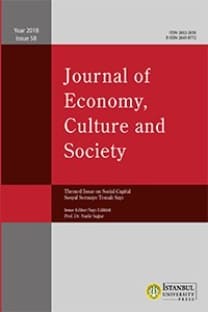SOMALİ’NİN ETİYOPYA BÖLGESİNDEKİ KADIN GİRİŞİMCİLERİN KARŞILAŞTIĞI ZORLUKLAR VE MOTİVASYON KAYNAKLARI
Kadın girişimciliğine yönelik geniş çaplı ilgiye 1980’lerde şahit olunmuştur. Kadın girişimciliğinin önünde finansal, kültürel, normatif sorunlar, hükümet düzenlemelerinden kaynaklanan kısıtlamalar, beşeri sermaye ve sosyal ağ sorunları olmakla birlikte birçok nedenle günümüzde sürekli daha fazla kadın iş kurmakta ve girişimci davranışları göstermektedir. Bu nedenler itici (gereklilik) etkenlerinden ve/veya çekim etkisi yaratan (fırsat) etkenlerinden olabilir. Çalışma, Etiyopya’nın Somali bölgesinden kasıtlı olarak seçilen 180 kadın girişimcinin zorluklarını ve motivasyonlarını ele almaktadır. Yönlendirilmiş yüz yüze anket çalışması 160 kadın girişimci ile yürütülmüştür. Çalışma sonucu göstermiştir ki kadın girişimcilerin mikrofinans kredileri için talep yaratmaları gerekmektedir. Çoğu kez işlerini ya kişisel tasarrufları ya da aile ve arkadaşlarından borç alarak kurmaktadırlar; bu da işin devamlılığı için bir kısıt olarak karşılarına çıkabilmektedir. Bu çalışmada kültürel zorluklar kadın girişimciliğinin önünde bir engel olarak bulunmamakla birlikte sosyal ağlar ve hükümet düzenlemeleri birer engel olarak öne çıkmıştır. Ayrıca kadın girişimcilerin bir gelir yaratma ve bağımsız olma istekleri ile motive oldukları da görülmüştür.
Anahtar Kelimeler:
Girişimcilik, Kadın Girişimciliği, Zorluklar, Motivasyon, Somali Bölgesi
CHALLENGES AND MOTIVATIONS OF WOMEN ENTREPRENEURS IN SOMALI REGION OF ETHIOPIA
It was only after 1980’s that great influx in to women entrepreneurship was witnessed. However, challenges faced by women entrepreneurs involves among, others, financial, human capital, network, cultural/normative challenges and government regulations. Yet nowadays women are more and more starting businesses and acting entrepreneurial for many reasons. These could be either of push (necessity) factors and/or pull (opportunity) factors. The paper examines challenges and motivations of 180 women entrepreneurs in Somali Region of Ethiopia who were purposively selected for the study. Administered face-to-face survey was conducted with 160 women entrepreneurs. The result of the paper shows that women entrepreneurs need demand creation in the area of microfinance loan applications. Women entrepreneurs start their businesses with their own personal savings and loans from family and friends, which is constraint to continuation of their businesses. Cultural challenges were not found to be barrier to women entrepreneurs in this paper, but the network challenges and government regulations were found to be challenges to women entrepreneurs. The paper also found that women entrepreneurs are motivated by the desire to generate income and become independent.
Keywords:
Entrepreneurship, Women Entrepreneurship, Challenges, Motivations, Somali Region,
___
- Abdul Shmaılın )2014). Women entrepreneurs in Saudi Arabia: Comparison of Barriers and Motovations: Moving from Disenfranchisement to Empowerment, Elite Research Journal of Education and Review, 2(2) pp. 6 - 21.
- Allen, I. E., N. Langowitz, and M. Minitti. 2007. Global Entrepreneurship Monitor, 2006 Report on Women and Entrepreneurship. Center for Women’s Leadership, Babson College, and London School of Economics.
- Andrea E. Smith-Hunter, (2006). Women Entrepreneurs Across Racial Lines, Issue of Human capital, Financial capital andNetwork capital, Edward Elgar Publishing Limited, UK.
- Anker, R. 2001. Theories of Occupational Segregation by Sex: An Overview, chapter 8 in Women, Gender and Work, edited by Martha Fetherolf Loutfi. Geneva, Switzerland: International Labor Office.
- Anne Marie Spevacek, (2010). Constraints of Female Entrepreneurship in Sub Saharan Africa: KCS research series report, USA
- Baughn, C.C., Chua, B., Neupert, K.E. (2006). The normative context for women’s participation in entrepreneurship: a multi country study. Entrepreneurship Theory and Practice, 30 (5), pp. 687-708.
- Beggs, J.J. 1995. The Institutional Environment: Implications for Race and Gender Inequality in the U.S. Labor Market. American Sociological Review, 60, 612-33.
- Birley, S. (1989), ‘Female entrepreneurs: Are they really any different?’, Journal of Small Business Management, 27 (1), 32-7.
- Bregger, J. 1996. Measuring Self-employment in the United States. Monthly Labor Review, 3-9.
- Bruin de, A., Brush, C. Welter, F. (2006). Introduction to the Special Issue: Towards Building Cumulative Knowledge on Women’s Entrepreneurship. Entrepreneurship Theory & Practice, Vol. 30, No. 5, pp. 585-593.
- ISSN: 2602-2656
- Yayın Aralığı: Yılda 2 Sayı
- Başlangıç: 1960
- Yayıncı: İstanbul Üniversitesi Yayınevi
Sayıdaki Diğer Makaleler
Siyasal Partilerin Doğuşu: Tarihsel Ve Toplumsal Kökenleri
Esneklik ve Güvencesizliğin Kaygan Zemininde Yeni Orta Sınıfın “Hareketliliği”
Yeme Pratikleri Üzerinden (Yeni?) Orta Sınıf(lar)ı Anlamaya Çalışmak
Kültürel Etkinlikler Aktörü Olarak Yeni Orta Sınıf ve Soylulaştırma İlişkisi Üzerine Bir Tartışma
Yükseköğretimde Büyüme, Farklılaşma ve Reorganizasyon: İstanbul Örneği (1980-2015)
Asi Şehirler: Şehir Hakkından Kentsel Devrime Doğru
Kadına Yönelik Şiddetin Dünü, Bugünü, Yarını: Kestirim Tabanlı Bir Araştırma
Serpil AYTAÇ, Fatma SERT ETEMAN, Gülşen ÇETİN AYDIN, Bircan REÇBER, Hayrettin Kemal SEZEN
